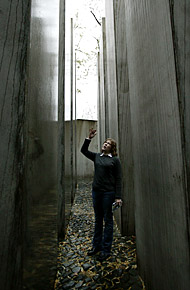Jüdisches Museum Berlin

Jüdisches Museum Berlin — by Caliandra Lanza-Weil ’06
Throughout the semester, our class work focused on architecture as a way of learning about Berlin; architect Daniel Libeskind, who designed the plans for a new World Trade Center in New York, created the Jüdisches Museum Berlin (Jewish Museum Berlin) to teach us about the Holocaust.
The building disorients and confuses the visitor, especially on the ground floor where the Holocaust is presented. Without meaning to sound weird, this is my favorite part of the museum. The floors are slanted, so you always feel as if you are about to trip. The displays are set into the walls so you have to peer into them. At one end you enter the Holocaust Tower, an empty concrete tower where you can hear the outside world but you’re sure the outside world cannot hear you, a very small idea of what it must have been like to experience the Holocaust.
The other exit takes you into the Garden of Exile where this picture was taken. The ground is uneven, the rocks are slippery, and the 49 pillars obstruct your view. The garden is meant to communicate that exile is a difficult experience, regardless of the fate that is being escaped.